It’s a summer evening and a safari boat ventures in to the backwaters. From nearly a mile away, the naturalist points out to the direction where elephants are grazing on the grasslands. The tourists are thrilled and amazed to spot elephants within minutes of their safari especially from such a distance. The boat gets closer and closer. The sight is mesmerizing for the tourists and it’s probably something they have never witnessed before.
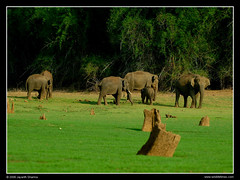 Practically in every direction they look at, plenty of elephants grazing, running behind each other, bathing in the waters, crossing the river, nurturing young ones, fighting for the right to mate, grazing peacefully can be seen. This is the spectacle of the annual elephant migration to the Kabini Reservoir during summer. Probably this is the best place in India to witness overwhelming numbers of wild elephants all in one place during this time. Practically in every direction they look at, plenty of elephants grazing, running behind each other, bathing in the waters, crossing the river, nurturing young ones, fighting for the right to mate, grazing peacefully can be seen. This is the spectacle of the annual elephant migration to the Kabini Reservoir during summer. Probably this is the best place in India to witness overwhelming numbers of wild elephants all in one place during this time.
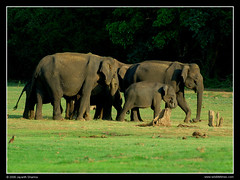 A country like India where children are born in hundreds every single time the clock ticks, the natural habitat of wild animals proportionately shrinks over a period of time. And for an animal as large as the elephant, real estate problems are in plenty. Elephants which once lived on practically every part of India have now shrunk to a very few patches of forest in the northern, north-eastern and southern part of India. South India alone is the home of approximately 15-20% of the Asiatic elephant population in the world. Having dry-deciduous forests and the tropical ever-green forests, elephants seem to thrive in large numbers in the national parks of south India. A country like India where children are born in hundreds every single time the clock ticks, the natural habitat of wild animals proportionately shrinks over a period of time. And for an animal as large as the elephant, real estate problems are in plenty. Elephants which once lived on practically every part of India have now shrunk to a very few patches of forest in the northern, north-eastern and southern part of India. South India alone is the home of approximately 15-20% of the Asiatic elephant population in the world. Having dry-deciduous forests and the tropical ever-green forests, elephants seem to thrive in large numbers in the national parks of south India.
On one such tiny stretch of forests in south India lies the Nilgiri Biosphere. Covering over 2000 square kilometers of area the biosphere consists of the Bandipur and Nagarahole national parks in Karnataka, Wayanad sanctuary in Kerala, and the Mudumalai Sanctuary in Tamil Nadu along with numerous small protected areas adjacent to these places. The Nilgiri biosphere spreading over the three neighboring states of south India, elephant herds live and thrive in this part of the world.
 The Matriarch, which is the eldest and the most experienced female of the herd, is usually the head of such herds of elephants. Consisting of females, calves, and young males the herd follows the orders of the Matriarch which guides the herd throughout the year in search of food, water and safe habitats. Through years of experience and transfer of knowledge from their mothers, the matriarchs’ knowledge of the forest is so immense that it has the whole map of the forest and its territory in the back of its mind. The Matriarch, which is the eldest and the most experienced female of the herd, is usually the head of such herds of elephants. Consisting of females, calves, and young males the herd follows the orders of the Matriarch which guides the herd throughout the year in search of food, water and safe habitats. Through years of experience and transfer of knowledge from their mothers, the matriarchs’ knowledge of the forest is so immense that it has the whole map of the forest and its territory in the back of its mind.
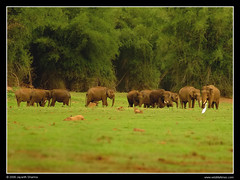 For hundreds of years, elephants have been following the same migratory routes in Asia as well as Africa in search of the best places to live during different times of the year. In recent years, such migratory paths are often disturbed by the ever increasing human population and urbanization. Coffee estates and tea plantations in such protected areas often hinders the movements of such herds between different places and as a result, Wildlife and Human beings come in to direct conflict. Affects of which, plenty of human casualties by attacks by herds, desperate for food and water and even elephant deaths which happen due to electrocution and human killing is witnessed. For hundreds of years, elephants have been following the same migratory routes in Asia as well as Africa in search of the best places to live during different times of the year. In recent years, such migratory paths are often disturbed by the ever increasing human population and urbanization. Coffee estates and tea plantations in such protected areas often hinders the movements of such herds between different places and as a result, Wildlife and Human beings come in to direct conflict. Affects of which, plenty of human casualties by attacks by herds, desperate for food and water and even elephant deaths which happen due to electrocution and human killing is witnessed.
 Like a boon to these elephants, the Nilgiri biosphere is still intact with all the corridors open for elephants of the neighboring states to visit the Kabini Reservoir during the heat of summer. During the end of October the Kabini Reservoir is drained to provide water to the farmers around this area. The decrease in water creates grasslands which are rich green and can sustain such number of elephants during the summer. Elephants start moving in to this part of the biosphere by March. As the summer progresses and the heat is on, more and more elephants descend from different parts of the biosphere to their annual symposium and festival of grazing. Matriarchs of many such herds meet each other, young ones feel free to play in the open amidst plenty of elders and tiny calves stick to their mothers to learn how to use their trunks for most things like eating, drinking etc. Young ones meet their cousins, elder brothers and sisters, members of different herds and often enjoy bathing and playing in the water. Like a boon to these elephants, the Nilgiri biosphere is still intact with all the corridors open for elephants of the neighboring states to visit the Kabini Reservoir during the heat of summer. During the end of October the Kabini Reservoir is drained to provide water to the farmers around this area. The decrease in water creates grasslands which are rich green and can sustain such number of elephants during the summer. Elephants start moving in to this part of the biosphere by March. As the summer progresses and the heat is on, more and more elephants descend from different parts of the biosphere to their annual symposium and festival of grazing. Matriarchs of many such herds meet each other, young ones feel free to play in the open amidst plenty of elders and tiny calves stick to their mothers to learn how to use their trunks for most things like eating, drinking etc. Young ones meet their cousins, elder brothers and sisters, members of different herds and often enjoy bathing and playing in the water.
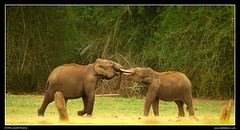 Adult bull elephants that normally leave the heard at the age of 15-20 years live their entire life in solitude. It’s usually the responsibility of the matriarch and other females of the herd to nurture the young ones and share responsibilities of the herd. Adult bull elephants that normally leave the heard at the age of 15-20 years live their entire life in solitude. It’s usually the responsibility of the matriarch and other females of the herd to nurture the young ones and share responsibilities of the herd.
 During such periods of large assemblies of herds around the grasslands of Kabini the adult bull elephants which are usually solitary and single feel the need to mingle. They often join different herds and check out for sexually receptive females to mate. Often more than one such bull elephant selects a particular female to mate and that is when the elephants have to rough it out to decide who gets to mate with the female. The winner walks away with the female and mates with her in peace. The loser usually accepts defeat and gets on with life in search of a different herd and a prospective mate nearby. Apart from claiming their right to mate, elephants usually don’t wish to quarrel with their neighbors and their peace loving nature often amazes the tourists with a sight such as the grasslands of Kabini filled with hundreds of elephant numbers. During such periods of large assemblies of herds around the grasslands of Kabini the adult bull elephants which are usually solitary and single feel the need to mingle. They often join different herds and check out for sexually receptive females to mate. Often more than one such bull elephant selects a particular female to mate and that is when the elephants have to rough it out to decide who gets to mate with the female. The winner walks away with the female and mates with her in peace. The loser usually accepts defeat and gets on with life in search of a different herd and a prospective mate nearby. Apart from claiming their right to mate, elephants usually don’t wish to quarrel with their neighbors and their peace loving nature often amazes the tourists with a sight such as the grasslands of Kabini filled with hundreds of elephant numbers.
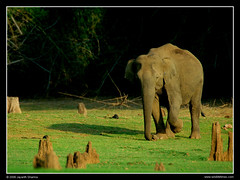 With every single adult consuming more than one hundred kilos of vegetation every day, the grasslands gradually gets worn out and by the end of May, there isn’t much to eat. Elephants unable to grip the short dry stubs, kick them and uproot them, make a ball of grass and dust away the mud to eat the remaining little portions of the grasslands. Bare patches of soil are exposed and during the next monsoon, there wouldn’t be any regeneration of such pastures. The arrival of monsoons start filling the reservoir with water which engulfs these grasslands which prompt the matriarchs to then start leading the herd back to their respective territories from they migrate to this heaven on earth. With every single adult consuming more than one hundred kilos of vegetation every day, the grasslands gradually gets worn out and by the end of May, there isn’t much to eat. Elephants unable to grip the short dry stubs, kick them and uproot them, make a ball of grass and dust away the mud to eat the remaining little portions of the grasslands. Bare patches of soil are exposed and during the next monsoon, there wouldn’t be any regeneration of such pastures. The arrival of monsoons start filling the reservoir with water which engulfs these grasslands which prompt the matriarchs to then start leading the herd back to their respective territories from they migrate to this heaven on earth.
The adult bull elephants stay back in these parts of the national parks to feed on the fresh vegetation and the bamboo shoots of this area. By this time they would have passed on their genes to the other females of the herd and the circle of life continues. Until the next annual symposium at Kabini in the next summer, the number of individuals decreases to a few herds from hundreds or probably even a couple of thousand elephant numbers near the backwaters.
Every one returns to their respective homes to only return back to the back waters of Kabini next summer.
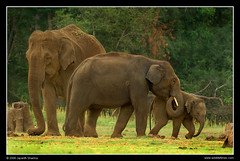 The Kabini example is a rare exception of a man made reservoir which drowns more than 25-30 square kilometers of the biosphere has resulted as a benefit to wildlife. How ever as this portion of the wild habitat continues to be the home of a healthy elephant population, gradually the traditional migratory paths of the herd seem to be getting affected. Many experts come across individuals which show sings of all the difficulties they have faced during their migration to this lush green part of the forests. Firing pellets at the intruding elephants by estate owners and coffee plantation workers often blinds elephants or leaves them with scars. Electric fences connected to high tension cables have killed elephants on numerous occasions or wounded them sometimes and even handicapped them for ever. The Kabini example is a rare exception of a man made reservoir which drowns more than 25-30 square kilometers of the biosphere has resulted as a benefit to wildlife. How ever as this portion of the wild habitat continues to be the home of a healthy elephant population, gradually the traditional migratory paths of the herd seem to be getting affected. Many experts come across individuals which show sings of all the difficulties they have faced during their migration to this lush green part of the forests. Firing pellets at the intruding elephants by estate owners and coffee plantation workers often blinds elephants or leaves them with scars. Electric fences connected to high tension cables have killed elephants on numerous occasions or wounded them sometimes and even handicapped them for ever.
One small patch on this globe is far too less for such a robust mammal to be protected and conserved. A much larger effort and planning is urgently needed to save elephants from disappearing from this planet. Though they are not as endangered as probably Tigers are, it’s high time we look at elephants and their habitats with serious concern.
“May the maximum number of Elephas maximus live on this planet forever” |
No comments:
Post a Comment